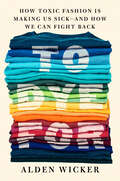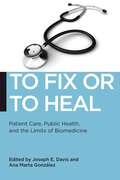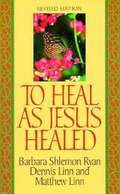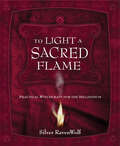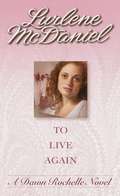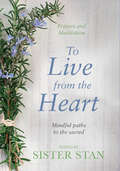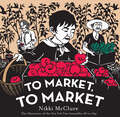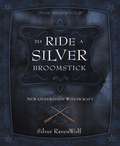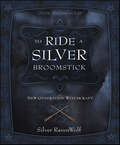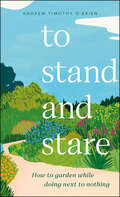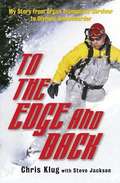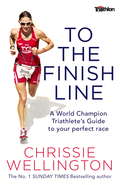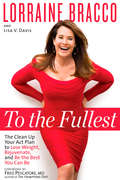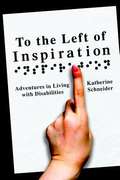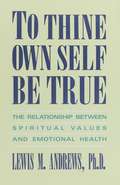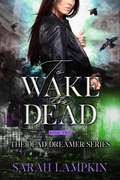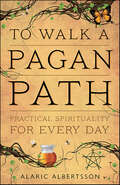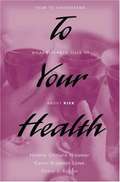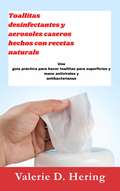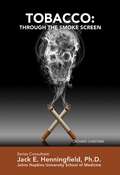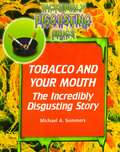- Table View
- List View
To Dye For: How Toxic Fashion Is Making Us Sick--and How We Can Fight Back
by Alden WickerA Silent Spring for your wardrobe, To Dye For is a jolting exposé that reveals the true cost of the toxic, largely unregulated chemicals found on most clothing today.Many of us are aware of the ethical minefield that is fast fashion: the dodgy labor practices, the lax environmental standards, and the mountains of waste piling up on the shores of developing countries. But have you stopped to consider the dangerous effects your clothes are having on your own health? Award-winning journalist Alden Wicker breaks open a story hiding in plain sight: the unregulated toxic chemicals that are likely in your wardrobe right now, how they&’re harming you, and what you can do about it.In To Dye For, Wicker reveals how clothing manufacturers have successfully swept consumers&’ concerns under the rug for more than 150 years, and why synthetic fashion and dyes made from fossil fuels are so deeply intertwined with the rise of autoimmune disease, infertility, asthma, eczema, and more. In fact, there&’s little to no regulation of the clothes and textiles we wear each day—from uniforms to fast fashion, outdoor gear, and even the face masks that have become ubiquitous in recent years. Wicker explains how we got here, what the stakes are, and what all of us can do in the fight for a safe and healthy wardrobe for all.
To Fix or To Heal: Patient Care, Public Health, and the Limits of Biomedicine (Biopolitics #3)
by Joseph E. Davis Ana Marta GonzálezDo doctors fix patients? Or do they heal them? For all of modern medicine’s many successes, discontent with the quality of patient care has combined with a host of new developments, from aging populations to the resurgence of infectious diseases, which challenge medicine’s overreliance on narrowly mechanistic and technical methods of explanation and intervention, or “fixing’ patients. The need for a better balance, for more humane “healing” rationales and practices that attend to the social and environmental aspects of health and illness and the experiencing person, is more urgent than ever. Yet, in public health and bioethics, the fields best positioned to offer countervailing values and orientations, the dominant approaches largely extend and reinforce the reductionism and individualism of biomedicine.The collected essays in To Fix or To Heal do more than document the persistence of reductionist approaches and the attendant extension of medicalization to more and more aspects of our lives. The contributors also shed valuable light on why reductionism has persisted and why more holistic models, incorporating social and environmental factors, have gained so little traction. The contributors examine the moral appeal of reductionism, the larger rationalist dream of technological mastery, the growing valuation of health, and the enshrining of individual responsibility as the seemingly non-coercive means of intervention and control. This paradigm-challenging volume advances new lines of criticism of our dominant medical regime, even while proposing ways of bringing medical practice, bioethics, and public health more closely into line with their original goals. Precisely because of the centrality of the biomedical approach to our society, the contributors argue, challenging the reductionist model and its ever-widening effects is perhaps the best way to press for a much-needed renewal of our ethical and political discourse.
To Heal as Jesus Healed
by Barbara Shlemon Ryan Matthew Linn Dennis LinnThe following quotes are taken from the back cover of the book: "Wonderful awesome things occur when the sick feel loved through the prayer and compassionate touch of caregivers." According to Barbara A Camden, the President of the Association of Christian Therapists, "This book assists and encourages caregivers to be vehicles of God's tender love and compassion. Simple explanations and real-life examples clarify the power of the Rite of Anointing of the Sick. Priests will find it especially helpful in dispelling the confusion and ignorance surrounding the Rite and in explaining its purpose and worth in any health care setting." The authors of the book, "DENNIS LINN and MATTHEW LINN, S.J. work together as a team (together with Sheila Linn), integrating physical, emotional and spiritual wholeness. They have worked as hospital chaplains and therapists, and have led courses and retreats on healing in over forty countries and in many universities and hospitals. They are the authors of fifteen books which have sold over a million copies in English and have been translated into more than fifteen different languages." Further, the author, "BARBARA SHLEMON RYAN is president of Beloved Ministry and chairs the Department of Pastoral Care for Trinity College of Graduate Studies. She travels nationally and internationally as a retreat director, workshop leader and conference speaker. Barbara is a founding member of the Association of Christian Therapists and a member of the Federation of Christian Ministries. She is the author of five highly successful books."
To Kiss Earth Good-Bye
by Ingo SwannParapsychology with chapters on out of body experiences, psychokinesis and prophecy.
To Light A Sacred Flame: Practical Witchcraft for the Millennium (Silver Ravenwolf's How To Series)
by Silver RavenWolfOriginally released in 1999, this bestselling guide to magickal practices-based on the experiences and successes of a third-degree working Witch-has been revised and updated! Written for today's seeker, To Light a Sacred Flame contains techniques that unite divinity with magick, knowledge, and humor.New coverNew interior designNew editUpdated artwork
To Live Again
by Lurlene McdanielDawn Rochelle looks like any other 17-year-old girl, but at the age of 13, Dawn was diagnosed with leukemia. Five years into remission, she suffers partial paralysis. Will she be able to find the strength and courage to live again?
To Live From The Heart: Mindful Paths To The Sacred
by Stanislaus Kennedy'This is a sacred treasury, a spiritual notebook which is very special to me, and which has touched and inspired me at different times over the years.'In To Live from the Heart: Mindful Paths to the Sacred, Sister Stan reveals how prayer can play an important part in all our lives, lifting our spirits and offering us hope and support in good times and bad.This comforting treasury of mindful meditations, prayers, proverbs and essays has helped to sustain Sister Stan through the years. In sharing them with us, she hopes they will nourish our souls, bring us peace on our journey through life, and inspire us to live from the heart.
To Love and Let Go: A Memoir of Love, Loss, and Gratitude
by Rachel Brathen“Rachel beautifully illustrates that loving fiercely and grieving deeply are often two halves of the same whole. Her story will break you down and lift you up.” —Glennon Doyle, author of the #1 New York Times bestseller Love Warrior and founder of Together RisingWhile on her way to teach a yoga retreat in March 2014, Rachel Brathen collapses at an airport, brought to her knees by excruciating stomach pains. She is rushed to the hospital on the tiny island of Bonaire, and hours later forced to undergo surgery. When she wakes up from anesthesia, her boyfriend is weeping at her bedside. While Rachel was struck down with seemingly mysterious pain, her best friend, Andrea, sustained fatal injuries as a result of a car accident. Rachel and Andrea had a magical friendship. Though they looked nothing alike—one girl tall, blond, and Swedish, the other short, brunette, and Colombian—everyone called them gemelas: twins. Over the three years following Andrea’s death, at what might appear from the outside to be the happiest time—with her engagement to the man she loves and a blossoming career that takes her all over the world—Rachel faces a series of trials that have the potential to define her life. Unresolved grief and trauma from her childhood make the weight of her sadness unbearable. At each turn, she is confronted again and again with a choice: Will she lose it all, succumb to grief, and grasp for control that’s beyond her reach? Or can she move through the loss and let go? When Rachel and her husband conceive a child, pregnancy becomes a time to heal and an opportunity to be reborn herself. As she recounts this transformative period, Rachel shares her hard-won wisdom about life and death, love and fear, what it means to be a mother and a daughter, and how to become someone who walks through the fire of adversity with the never-ending practice of loving hard and letting go.
To Market, to Market
by Nikki McClureFrom the New York Times-bestselling artist. “Exact, masterful cut-paper illustrations bring the market’s smells, produce, bustle and cheery people to life.” —Kirkus Reviews (starred review)WINNER: Washington State Book Award, Children’s Picture BooksKnown for art that celebrates the virtues of community, hard work, and living gently on the planet, Nikki McClure here explores a topic close to her heart: the farmers market. Alternating between story and fact, this lovingly crafted picture book follows a mother and son to the weekly market. As they check off items on their shopping list, the reader learns how each particular food was grown or produced, from its earliest stages to how it ended up at the market. To Market, to Market is a timely book that shines awareness on the skill that goes into making good food.“McClure’s papercuts of windblown hair, vegetable leaves, craftsmen at work, and beds of hay continue to delight. This is, in effect, two books in one: younger readers can stick to the gentle introductions to sections about kale, smoked salmon, honey, blueberry turnovers, cheese, and even napkins; older children will appreciate (and have the patience to sit through) each product’s path to market.” —Publishers Weekly“Astonishingly detailed.” —School Library Journal
To Ride a Silver Broomstick: New Generation Witchcraft
by Silver RavenwolfThis is an introductory text on the study and practice of Wicca. It comes from an eclectic background and is suitable for men and women. It is a respectful and straightforward approach to the religion of witchcraft.
To Ride a Silver Broomstick: New Generation Witchcraft
by Silver RavenWolfThis popular guide has been helping a new generation of Witches—those practicing or wishing to practice the Craft on their own—for decades. Summon. Scry. Spin, spiral, and sweep. Learn how to bend time, draw down the moon’s energy, and use mirror magick. Whether novice or adept, a Witch’s world is filled with wonder and magick. It’s also filled with the hard work and dedication to learning that are part of living the Craft every day. Silver RavenWolf presents a fascinating introduction to the Craft in To Ride a Silver Broomstick, the first volume in the tremendously popular Witchcraft series that also includes To Stir a Magick Cauldron and To Light a Sacred Flame. This indispensable guide presents tried-and-true Witch wisdom, dished out with Silver’s down to earth warmth and humor. You’ll learn the essentials of Witchcraft, including: WebweavingAural projection, bilocation, and power animalsStocking your magickal cabinetCleaning, consecrating, and chargingThe Summerland death, reincarnation, and timeFinding your magickal nameHealing techniquesDeities and pantheonTelepathy, psychometry, and mind powerThe Wheel of the YearGems, herbs, and healingColor, candle, and sympathetic magick
To Shine One Corner of the World
by David ChadwickParaphrased from the book cover: Shunryu Suzuki has an extraordinary gift for bringing to life traditional Zen teaching in ordinary language. Here we see how his students saw him and what they remember that stayed with them when more elaborate discussions did not. He managed to put seemingly complicated ideas in short, simply statements that contained depths of understanding and compassion and often tinged with a lovely sense of humor.
To Spoil the Sun
by Joyce RockwoodA classic about the devastation of smallpox is back in hardcover after many years"'You cannot imagine what it [smallpox] is like. It falls on everyone and soon there is no one who can stand. It is like a fire that sweeps through the town, an invisible fire. People begin to fall with fever, and blisters rise on their skin and turn to running sores, and there is no way to give them comfort.'I reeled at the force of it, horror-struck, unable to imagine it."It is the sixteenth century and Rain Dove, a young Cherokee girl, lives in Mulberry Town. If things continue the way they always have, she can look forward to choosing a husband (her grandmother advises picking a young warrior) and raising a family. But after smallpox strikes, life for the people of the Seven Clans will never be the same.
To Stand and Stare
by Andrew Timothy O'BrienReconnect with nature from the ground up and nurture not only your garden but your body, mind, and soul.There&’s a lot of advice out there that would tell you how to do numerous things in your garden. But not so much that invites you to think about how to be while you&’re out there. With increasingly busy lives, yet another list of chores seems like the very last thing any of us needs when it comes to our own practice of self-care, relaxation and renewal. After all, aren&’t these the things we wanted to escape to the garden for in the first place? Put aside the &‘Jobs to do this week&’ section in the Sunday papers. What if there was a more low-intervention way to garden, some reciprocal arrangement through which both you and your soil get fed, with the minimum degree of fuss, effort and guilt on your part, and the maximum measure of healthy, organic growth on that of your garden? A gardening book unlike anything you've read before:- A celebration of the quiet joy of gardening, and the importance of delighting in nature's wonders.- A season-by-season reflection of the garden's rhythms and our place within them.-An exploration of the natural processes at work in the garden and how tapping into them can transform both your gardening experience and your life.In To Stand and Stare, Andrew Timothy O&’Brien weaves together strands of botany, philosophy and mindfulness to form an ecological narrative suffused with practical gardening know-how. Informed by a deep understanding and appreciation of natural processes, O&’Brien encourages the reader to think from the ground up, as we follow the pattern of a plant&’s growth through the season – roots, shoots, flowers, and fruits – while advocating an increased awareness of our surroundings.
To the Edge and Back: My Story from Organ Transplant Survivor to Olympic Snowboarder
by Steve Jackson Chris KlugStory of Chris Klug, Olympic snowboarder. His life, dreams, and organ transplant survival.
To the Finish Line: A World Champion Triathlete’s Guide To Your Perfect Race
by Chrissie WellingtonBeing mentored by Chrissie Wellington would be a dream for any triathlete. In To The Finish Line Chrissie presents her distilled wisdom, hard-won over the course of her extraordinary career, to give all triathletes the chance to learn from the very best.Chrissie writes with emotional honesty, and her warmth and sense of humour also shine through. She speaks frankly about her own experiences - both good and bad - from her career. Such stories will be a source of great inspiration to readers.The book will also be an invaluable practical resource for triathletes. It contains a significant amount of easily-applicable advice on subjects ranging from training tips through to mental strength, transition techniques and nutrition.
To the Fullest: The Clean Up Your Act Plan to Lose Weight, Rejuvenate, and Be the Best You Can B e
by Lorraine Bracco Lisa DavisLorraine Bracco is one of the world's most dynamic actresses, but when she reached her fifties, she felt she was losing her luster. During the long illnesses of her parents, she began to gain weight and felt her energy and self-confidence take a dive. Watching her parents die within 9 days of each other was her wake-up call to take charge of her life. She made a commitment to herself to stay healthy. <P><P>In To the Fullest, Bracco presents her Clean Up Your Act Program, a comprehensive plan to help women over 40 look and feel younger. The program includes an intensive liver cleanse to reboot the body to start fresh on the path to optimal health by eliminating gluten, sugar, eggs, and dairy. Two weeks of meal plans and a varied list of meals and snacks illustrate that hunger is not part of the program and that eating clean has endless flavorful options. Her Clean Up Your Act Diet, which follows the cleanse, will help you lose pounds and deliver supercharged energy. Bracco adds her own mouthwatering recipes to ease the transition to clean eating and suggests an abundance of satisfying breakfasts, lunches, dinners, and snacks. She gradually lost 35 pounds and has kept it off. <P> The book also includes testimonials gathered from women who have participated in Rodale's 6-week test panel.With winning honesty, Bracco provides the perfect combination of humor, comfort, and motivational support that women need to rise to life's challenges. From attitude adjustments to style tips, from finding new passions to making movement a habit, her advice and personal insights both inspire and entertain.
To the Left of Inspiration: Adventures in Living with Disabilities
by Katherine SchneiderWhen is the last time you've read an honest, funny book about living with disabilities? To the Left of Inspiration: Adventures in Living with Disabilities is just such a book. You'll learn from a woman blind from birth about activities of daily life, like talking to children about disabilities, traveling, going to church, and working. Great memoirs about amazing people with disabilities exist, as do hundreds of books about the diagnosis and treatment of a particular disability. There are also books for specialists about teaching, rehabilitating, or accommodating a particular kind of disability. Since the passage of the Americans with Disabilities Act, more and more people interact daily with students, customers, and clients with disabilities and want to do so knowledgeably and sensitively. The life experiences Schneider describes to exemplify her suggestions to the reader highlight the warmth and humor in all of our struggles to be humane with each other, whether we are temporarily able-bodied or disabled. Fifty-four million Americans have chronic illnesses or disabilities requiring them to make accommodations in the ways they live their lives. They have families, friends, coworkers, teachers, health care professionals, and church leaders who want to know what their disabled friend is going through and how to help. Schneider writes about living with blindness for over fifty years and fibromyalgia for ten years.
To Thine Own Self Be True: The Relationship Between Spiritual Values and Emotional Health
by Lewis M. Andrews"There is a newfound confidence and enthusiasm for living. But perhaps the most remarkable development of all is the recognition that this spiritual therapy is not really a new discovery, revealed by some outside authority, as much as it is a reminder of the basic truths we have always known in our own hearts. In healing ourselves, we learn that the greatest wisdom of all lies not in listening to others but in being true to our deepest selves".
To Wake the Dead (The Dead Dreamer Series #2)
by Sarah Lampkin"It’s not often that I find the second book in a series better than the first. Yet, here it is, the mythical favored second book." - Verified Reviewer"Hang on for high tension, wicked fast twists and the inner turmoil between Brenna and her dark soul, Maura." - Verified ReviewerBrenna Whit teeters the line between the living and the dead. Now that she's back for her sophomore year at Nephesburg College, she's determined to focus on the waking world. But when her own soul is trying to kill her and a new Dead Dreamer is fighting for power, Brenna is dragged back into the world of the dead. The Gatekeepers are doing everything they can to restore the power they once held over the town of Nephesburg. With a mysterious set of twins arriving in town to help them prepare, Brenna must decide what's important: continuing to hide her secret or reveal herself and fight for what she believes is right. The decision could end up leading to permanent death for Brenna so she must choose wisely. Classes have begun...The battlefield is set...Let the fight for the Fade begin.
To Walk a Pagan Path: Practical Spirituality for Every Day
by Alaric AlbertssonInspiration and Ideas for a Holistic Pagan LifestyleLive fully as a Pagan every day of the year, not only on full moons and holidays. With practical tips for integrating earth-centered spirituality into every aspect of life, To Walk a Pagan Path shows you how to:Cultivate a meaningful Pagan practice by following seven simple steps.Develop a sacred calendar customized for your beliefs, lifestyle, and environment.Make daily activities sacred with quick and easy rituals.Reclaim your place in the food cycle by producing a portion of your own food—even if you live in an apartment!Express Pagan spirituality through a variety of craft projects: candles, scrying mirrors, solar wreaths, recipes, and more.Create sacred relationships with animal familiars.
To Your Health: How to Understand What Research Tells Us About Risk
by Helena Chmura Kraemer Karen Kraemer Lowe David J. KupferThis is a guide to the critical reading of risk research reports directed to informed consumers, physicians, as well as to scientists evaluating the risk research literature or contemplating risk research projects.
Toallitas desinfectantes y aerosoles caseros hechos con recetas naturales: Una guía práctica para hacer toallitas para superficies y mano antivirales y antibacterianas
by Valerie D. HeringCon el estado actual de la salud mundial y la pandemia que afecta a millones de personas que tratan de protegerse a sí mismas y a sus seres queridos contra la enfermedad infecciosa, es natural que todos busquen maneras de obtener fácilmente toallitas y aerosoles antivirales caseros, toallitas para manos y desinfectantes ante la inminente escasez de los materiales esenciales. A continuación se resumen los hechos importantes que descubrirá en esta guía: •Qué son los gérmenes y cómo protegerse a sí mismo y a su familia contra los patógenos; cómo se propagan los gérmenes y cómo romper el círculo. •Cómo hacer diferentes tipos de toallitas desinfectantes antibacterianas y antivirales •Las formas aprobadas por la OMS de lavarse las manos •Cómo hacer toallitas para bebés •Cómo hacer aerosoles desinfectantes antivirales • Cómo hacer aerosoles y toallitas a base de hierbas •Recetas sencillas para hacer un limpiador desinfectante para el baño y el inodoro •Instrucciones sencillas para lavarse las manos •Biología y estructura simple de los patógenos- ¡Y mucho más!
Tobacco: Through the Smoke Screen (Illicit and Misused Drugs)
by Zachary ChastainIt has been used in sacred ceremonies, in medicine, and as a life-saving cash crop in the New World. But today, tobacco is a problem--a big problem. It is one of the first substances to which young people become addicted, and it contains thousands of chemicals that are dangerous to smokers and to those who are simply in the proximity of the smoke. In Tobacco: Through the Smoke Screen, you'll learn the story of tobacco, its history, its role in culture, and its dangers. You will also learn about the power of tobacco over smokers and chewers, and how cigarette makers help increase its hold--and make it more difficult to live without it. Last of all, you'll find suggestions on how to kick the tobacco habit and reverse its ill effects.
Tobacco and Your Mouth: The Incredibly Disgusting Story
by Adam Winters Michael A. SommersResearch shows that drug abuse prevention efforts in the preteen years lead directly to lower rates of drug use during the teen years. But middle-school readers are not easily swayed by oversimplified "just say no" messages. This new series delivers its message in a dramatic and effective way: by telling -- and showing -- readers the harsh realities of the physical effects of drugs, alcohol, and tobacco. Using graphic medical photos and clear, vivid text, this unique series is a hard-hitting and fascinating weapon in the war against teen drug abuse.<P>Every cigarette you smoke takes twelve minutes off your life! In graphic detail, this book illustrates the horrifying mess that tobacco makes of your mouth -- discussing everything from gross yellow teeth to really stinky breath. Aside from explaining why cigarettes are so bad for you, the author also offers helpful suggestions on how to quit this bad habit.
